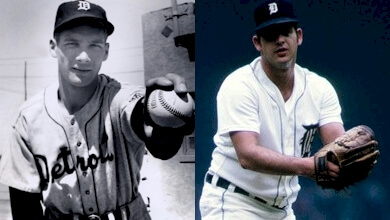
Mickey Lolich (right) and Hal Newhouser (left) rank first and third all-time in strikeouts for the Detroit Tigers.
Mickey Lolich turned 75 years old on September 12.
He’s three-quarters of the way to the century mark, which I believe makes it as good a time as ever to see how his 13 seasons in Motown stack up with other all-time Tigers pitching greats.
When comparing the best of the best or really any set of major leaguers, I like to first look at the wins above replacement (WAR) produced by the group of players.
To no surprise, Lolich ranks among the top five in WAR produced by a Tiger pitcher in franchise history, according to Baseball Reference.
In fact, the Portland, Ore., native is third all-time in WAR among Tigers pitchers, and the only two men he trails in the statistic are Tommy Bridges and Hall of Famer Hal Newhouser – both of whom pitched for the franchise’s championship squad of 1945.
I like to look at how well a starting pitcher fared in the World Series to measure his clutch factor.
It’s important to note that Bridges made five starts in the Fall Classic in 1934, 1935, and 1940, picking up four victories, all of them via the complete game. For his career he posted a 3.52 ERA in the World Series in 46 innings. He’s the only Detroit pitcher to appear in four World Series (he made a brief relief appearance in ’45 at the tail end of his career).
Newhouser didn’t fare much better overall in the ’45 Fall Classic, as he recorded a six-plus ERA in three games started and 20.2 innings pitched.
In comparison, Lolich was lights out in nearly seven more innings pitched in the 1968 Series, permitting a total of five earned runs and six walks en route to three victories, an ERA below two and Most Valuable Player honors for the effort.
Like Newhouser, Bridges and Lolich, Dizzy Trout (#4 all-time in WAR for Detroit hurlers) and Justin Verlander (currently #5 and rising) also recorded or have recorded WARs above 40 in their respective careers.
Despite experiencing such success in the regular season during their respective careers, both Dizzy and JV suffered or have suffered through disappointing performances in the Fall Classic.
Verlander, for one, has an ERA of 7.20 in 15 career innings pitched and three combined starts made during the 2006 and 2012 Fall Classics.
Then, there’s Trout, who got rocked in his lone outing in the 1940 World Series, allowing two earned on six hits in only two innings pitched against the eventual champion Cincinnati Reds.
And yes, I know that Paul Howard “Dizzy” Trout pitched brilliantly in the ’45 Series, putting up an ERA and WHIP below one. However, he put up those numbers in 13.1 less innings than Lolich in his stellar, MVP-winning performance in ’68.
It tells me that Lolich had a larger influence on the club winning in ’68 than Dizzy had on the club winning in ’45.
For me, it also means that Lolich had a more impressive career donning the “Old English D” than did the man with the funny nickname who pitched for nearly 14 full seasons on the corner of Michigan and Trumbull.
With all this being said, it would be silly for me to think that the measure of a pitcher’s success is based upon only his career wins above replacement total and his ability to get it done in the final days of October.
There’s one other stat to take into account, and that is fielding independent pitching.
As FanGraphs explains, it’s a statistic that estimates a pitcher’s ability to prevent runs without his team’s defense and its deficiencies being taken into account.
The stat is a true measure of a pitcher’s success in a given season plus over the course of a career, in my opinion.
In evaluating all five pitchers’ career FIPs, only Bridges was taken out of consideration for the greatest Detroit pitcher in franchise history.
It’s because he was the lone pitcher and starting arm of the five to fail to post a career FIP of three and a half or lower.
Of the other four, Newhouser and Lolich possess the best career FIPs with marks of 3.18 and 3.19, respectively.
When it comes down to it, Newhouser has Lolich beat in two of the three categories that I have established as qualifications for receiving the nod of greatest Tigers pitcher of all-time.
And he didn’t totally stink it up in the category that Lolich has the edge in: the World Series.
After getting off to a slow start in his first trip to the World Series with eight runs allowed and seven earned in game one against the Cubbies in ‘45, the Detroit native and lanky lefty allowed a combined seven runs in two other starts – the last of which was a complete game victory in game seven.
It’s why “Prince Hal” ultimately gets the nod as the best pitcher in club history, but Lolich is right behind him and his three wins in the ’68 Series have a lot to do with it.
Trout and Verlander are the next best things at No. 3 and No. 4, respectively, among the club’s all-time pitching greats, and the gap between the two of them and Newhouser and Lolich isn’t really close.
It’s why Newhouser and Lolich should be firmly entrenched as the two best hurlers in club history.



One reply on “Newhouser and Lolich are best starting pitchers in Tigers’ history“
Comments are closed.